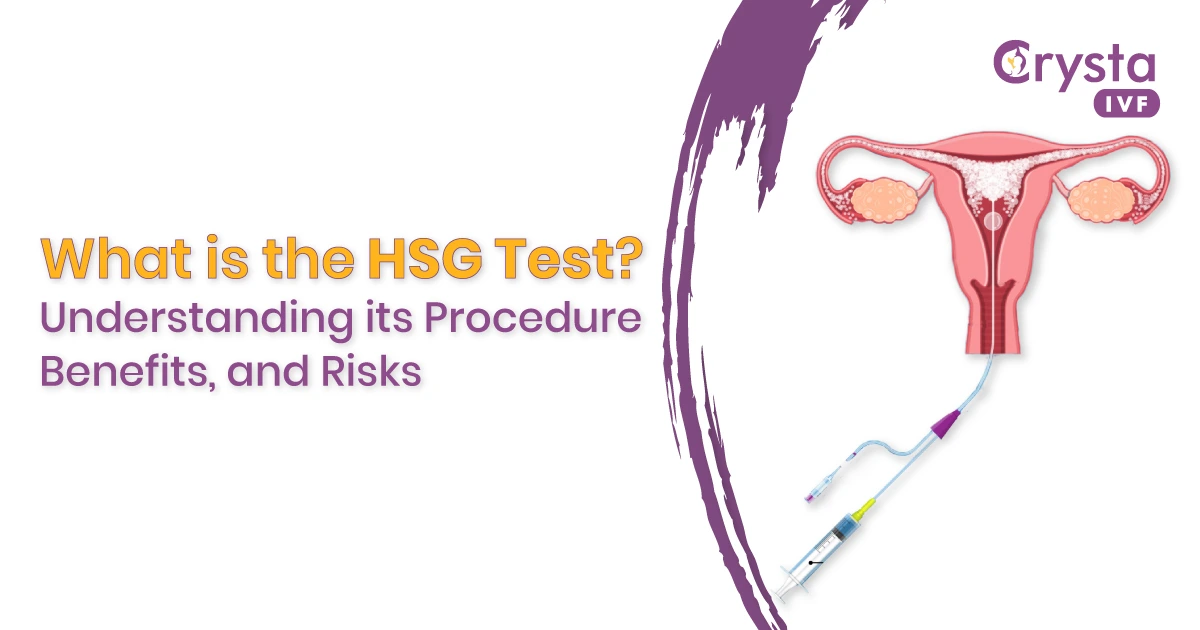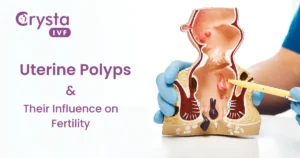If you and your partner have been trying to conceive a baby and still haven’t had any success, your doctor may suggest certain tests to check for hidden fertility issues. One of the most common tests is the HSG test. For those wondering what HSG’s full form is, it stands for Hysterosalpingogram. This test uses a special X-ray and contrast dye to look at the shape of your uterus and check if your fallopian tubes are open.
Many women feel a little nervous before the test, but it is generally safe and takes only a short time to perform. From understanding when and how the test is conducted to examining its potential benefits and risks, this blog aims to provide clarity for women who cannot conceive and are wondering why.
What is an HSG Test (Hysterosalpingogram)?
An HSG test (Hysterosalpingogram) is an X-ray test that helps doctors check a woman’s uterus and fallopian tubes. In this test, a special dye is put into the uterus through the cervix, and X-ray images are taken. The dye shows if the fallopian tubes are open or blocked and if the shape of the uterus is normal.
It is usually recommended for women facing difficulty in getting pregnant. The test is simple, takes about 15 – 30 minutes, and gives important information about possible fertility problems. Though it may cause mild discomfort, it helps doctors plan the right treatment.
What is the Purpose of the HSG Test?
The main purpose of an HSG test is to find out if a woman’s fallopian tubes are open and if her uterus is healthy. Blocked tubes or problems in the uterus can make it hard to get pregnant.
However, here are some more reasons why the HSG test is performed:
- It checks if the fallopian tubes are open or blocked.
- It examines the shape and structure of the uterus.
- Detects problems like scars, fibroids, or adhesions.
- Helps find the cause of infertility or difficulty in conceiving.
- Guides doctors to choose the best fertility treatment.
- Sometimes, it also improves fertility by flushing out minor blockages.
When is the HSG Test Recommended?
The HSG test is usually recommended when a woman is facing difficulty in getting pregnant or if a doctor suspects problems in the uterus or fallopian tubes.
The HSG test is often suggested in the following situations:
- When trying to conceive for 6–12 months without success.
- After a history of pelvic infections or sexually transmitted infections.
- After a woman undergoes an ectopic pregnancy.
- After a miscarriage or uterine surgery to check for healing and tube health.
- If there are signs of uterine abnormalities such as fibroids, polyps, or adhesions.
- As part of a fertility assessment before treatments like IUI or IVF.
How to Prepare for an HSG Test?
- Schedule the test at the right time, usually after your period ends but before ovulation (Day 7–10 of your cycle) to avoid pregnancy and get clear results.
- The IVF specialist may prescribe a course of antibiotics if you have a history of pelvic inflammatory disease (PID) or dilated fallopian tubes.
- Wear comfortable clothing for the procedure and eat lightly before the test to avoid discomfort.
- It is suggested that you take ibuprofen or any kind of painkiller (based on the doctor’s advice) before the HSG test, as it can become painful.
- Discuss any and all questions you might have about the test with your doctor ahead of the test.
- Ensure you have a ride back home, as the test can cause discomfort even after it ends.
Step-by-Step Guide to HSG Test Procedure
Here’s a detailed guide on how the HSG test is done.
Step 1 – Preparation:
Preparation: Consult your doctor regarding the procedure and explain your concerns. The doctor will explain everything to you so your process will start easily. Also, wear comfortable clothes on the day of the test and do not wear any jewellery.
Step 2 – Processing:
Before the test begins, you will be advised to empty your bladder. Also, inform the doctor of any allergy or prior health condition.
Step 3 – Examining the Cervix:
The radiologist will then gently insert a speculum into the vagina, clean the cervix, and carefully introduce a catheter into the uterus. Some women experience mild to medium level discomfort when this happens. If the discomfort grows, inform your doctor immediately.
Step 4 – Contrast (Dye) Insertion:
Contrast (Dye) Insertion: A dye is inserted into the uterus and fallopian tubes. This helps with the X-ray imaging as it shows whether there are any abnormalities in the uterus or fallopian tubes.
Step 5 – Adding the Contrast:
A thin, flexible tube (catheter) is carefully inserted into the uterus. A special liquid called contrast material or dye is slowly released through the tube while pictures are taken. The dye helps with the diagnosis of whether there are any abnormalities in the uterus. You can also be asked to change your position for better imaging.
What to Expect After the HSG Test?
- Post-Procedure: Once the imaging is done, the catheter is removed, and you will be given a pad for any possible spotting or leakage. Some women also encounter some levels of cramping, so it is highly advised to rest and not get up quickly.
- Result Discussion: If there is an abnormality in the shape of the uterus, the dye will highlight it. But if there are no abnormalities in the uterus or fallopian tubes, the dye spills into the pelvic cavity, where the body resorbs it. Based on the HSG Test Report, the doctor will highlight if there are any concerns, and further tests may be recommended based on the findings.
- Aftercare: It’s normal to experience mild cramps and spotting for a day or two. But you can resume your normal day-to-day activities after consulting with your doctor.
Understanding the HSG Test Results
After an HSG test, your doctor will explain the results to help you understand your fertility condition and plan the next steps. The results generally fall into two categories: normal or abnormal.
- A normal result means your fallopian tubes are open and your uterus has a healthy shape.
- An abnormal result can indicate blockages in the tubes or issues in the uterus that may require further treatment.
Here’s a simple table to understand HSG results:
| Finding | What It Means |
| Dye flows freely into the uterus and tubes | Fallopian tubes are open and the uterus’s shape is normal |
| Blocked fallopian tube(s) | Fertility may be affected; egg and sperm cannot meet naturally |
| Irregular uterine shape, polyps, fibroids, and adhesions | Structural problems that can affect implantation or cause miscarriage |
Crysta IVF Expert Doctor’s Recommendation on HSG Test:
“As a fertility specialist, I often recommend the HSG test because it gives a clear view of the uterus and fallopian tubes. Understanding the results is important for planning the next steps in your fertility journey. A normal result is reassuring, but if there are blockages or uterine issues, we can address them early with the right treatment, improving the chances of pregnancy.”
~ MBBS, M.S., Fellowship in Reproductive Medicine
HSG Test for Female Infertility in Simple Words
What are the Benefits of the HSG Test?
The HSG test offers several important benefits for women who are trying to conceive. It helps doctors clearly see if the fallopian tubes are open and whether the uterus has any abnormalities.
Here are some of the benefits of an HSG test:
- Helps diagnose fertility problems: HSG can help diagnose fertility problems such as blocked fallopian tubes and an irregularly shaped uterus.
- Help plan further imaging: HSG Test helps plan additional imaging or procedures, like a laparoscopy if required. Additionally, the test also helps in revealing uterine irregularities, which may aid in the planning of additional imaging.
- Increases natural possibility of pregnancy: According to a study, women who underwent an HSG test had a higher chance of becoming pregnant within the first six months of trying than those who did not. The study also discovered that a woman’s chance of becoming pregnant increased if her blocked tube was cleared during the test.
What are the Risks and Side Effects of an HSG Test
The HSG test is generally safe, but like any medical procedure, it can have some side effects. Here are some of the risk factors of an HSG test:
- Radiation Risk: The hysterosalpingogram or HSG Test uses X-ray imaging with minimal radiation. The procedure is safe, and the benefits outweigh the risks.
- Infection: While uncommon, there is still a slight risk of infection with HSG. Although proper sterilization is done on the equipment, it is still advised to self-observe for any signs of post-procedure infection. If anything occurs, immediately consult your doctor.
- Uterine Injury and Allergic Reaction: The possibility of uterine injury can be the reason for bleeding after the HSG test and allergic reactions to the dye solution. Though infrequent, these complications underscore the importance of medical professionals monitoring patients closely during and after the test for prompt intervention if needed.
What is the cost of an HSG Test in India?
The cost of an HSG (Hysterosalpingogram) test in India usually ranges between ₹2,000 and ₹8,000, depending on the city, clinic, and facilities. The price generally includes the procedure, contrast dye, and X-ray imaging, but additional charges may apply for consultation or pain relief medication.
When Should You Call Your Doctor After an HSG Test?
If you encounter any of the following signs or symptoms after the HSG test, it’s time to call your doctor.
- Fever
- Chills
- Fainting
- Vomiting
- Heavy vaginal bleeding
- Foul-smelling vaginal discharge
- Severe cramping in your abdomen
A note from Crysta IVF
The HSG Test may feel like more complications, but it’s another way to help you achieve a successful pregnancy. Crysta IVF is the best fertility clinic in Delhi, and our experienced doctors and embryologists prioritize your comfort and work on removing all the roadblocks in your path to parenthood. A clear HSG result is like an open door that allows you to explore various fertility options, all leading to making your dream come true. Even if there are blockages, our doctors will curate a personalized treatment plan to remove them or suggest alternative treatments. When in doubt, don’t hesitate to reach out. We are here to answer your questions, address your concerns, and support you every step of the way.
Also Read:
What are the causes of female infertility?
What are the chances of getting pregnant with one Fallopian tube
Unlocking A 7-Step Guide for Overcoming Blocked Fallopian Tubes
FAQs:
Is HSG test painful?
You may feel mild cramping or discomfort during the HSG test, similar to period pain. Some women also experience slight spotting afterwards.
Which day of the cycle is best for HSG?
The best time for an HSG test is between days 7 and 10 of your menstrual cycle, after your period ends but before ovulation. This ensures you are not pregnant and gives clear results.
How long after an HSG can I try to conceive?
You can usually try to conceive right after your next menstrual cycle, unless your doctor advises otherwise. Some doctors recommend waiting a cycle to allow the uterus to recover.
Can an HSG test unblock the fallopian tubes?
In some cases, the dye used during an HSG test may help open minor blockages in the fallopian tubes, slightly improving fertility. However, it is not a guaranteed treatment for blocked tubes.
Is anaesthesia required for the HSG test?
No, anaesthesia is not usually needed for an HSG test. The procedure is quick, but mild pain relief or anti-cramping medication may be given to make you more comfortable.
How safe is the HSG test during infertility evaluation?
HSG is generally safe and widely used for infertility checks. It uses a small amount of radiation that is considered safe, and serious complications are rare when performed by an experienced doctor.
Can a hysterosalpingogram increase the chance of pregnancy?
Inserting dye into the uterus is called “Tubal Flushing.” Some studies have shown that this process improves fertility as the dye, an oil-soluble contrast, clears out blockages.
What are the signs of blocked fallopian tubes?
Strong to moderate abdominal pain, fever, painful periods, strange-looking or smelly vaginal discharge, or pain during sex or urination are some possible symptoms, depending on the individual.
How can I clear out my Fallopian Tubes naturally?
Here are some foods that can help clear out Fallopian Tubes naturally:
- Turmeric
- Vitamin C-rich food
- Ginger
- Garlic
- Castor Oil
- Fertility Massage




